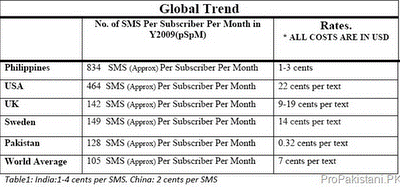Pakistan Leads the World in Low Cost Texting
By Riaz Haq
CA
Pakistan's 152 billion text messages and Rs. 40 billion in texting revenue in 2009-10 put it among the top-ranking nations for sms traffic, says a report produced by Pakistan Telecommunications Authority (PTA).
The main driver for growth of texting in Pakistan has been its low cost compared with voice calls, a key reason for many users, including illiterate phone users, to be attracted to using text messages to communicate, according to a study done by Alex Gilchrist and Jim Linton Williams of the UK-based Popular Policy Engagement Lab. They start by asking literate relatives and friends to read text messages to them, and sometimes ask them to type messages for them as well. Gradually, they also learn to read and type text messages themselves.

Education:
A recent Brookings Institution paper titled A New Face of Education: Bringing Technology into the Classroom in the Developing World compared the effective use of cell phone text messaging in Pakistani schools with the failure of One-Laptop-Per Child (OLPC) scheme in Peruvian schools. It highlights Mobilink-UNESCO program to using text messaging increase literacy skills among rural girls in Pakistan. Each girl in the program uses her mobile phone to send an SMS message in Urdu to her teacher. After sending, she receives messages from her teacher in response, which she copies by hand in her notebook to practice her writing skills. Here's how Brookings paper describes the results:
"Initial outcomes look positive; after four months, the percentage of girls who achieved an A level on literacy examinations increased from 27 percent to 54 percent. Likewise, the percentage of girls who achieved a C level on examinations decreased from 52 percent to 15 percent. The power of mobile phone technology, which is fairly widespread in Pakistan, appears in this case to help hurdle several education barriers by finding new ways to support learning for rural girls in insecure areas — girls who usually have limited opportunities to attend school and who frequently do not receive individual attention when they do. Often they live in households with very few books or other materials to help them retain over summer vacation what they learned during the school year."
The Brookings report compares the use of low-cost, simple and ubiquitous cell phone technology for education in Pakistan with the deployment of relatively more expensive, more complicated and much less ubiquitous laptops to educate children as part of One-Laptop-Per-Child program in Peru. Here's how the Brookings paper describes it:
"In Peru, a number of colorful laptops sit in a corner of a classroom covered with dust. Given to the school through a One Laptop Per Child program arranged by the Ministry of Education, the laptops were intended to improve students’ information communication technology (ICT) skills, as well as their content-related skills. Without the proper support for teacher training in how the laptops are used, with no follow-up or repair and maintenance contingencies, and with outdated and bug-infested software, the laptops are seen as unusable and serve little purpose. In this case, technology has not helped improve the educational experience of learners."
Health Care:
Mobile communications service provider Mobilink has recently partnered with the United Nations Population Fund (UNFPA), Pakistan's Ministry of Health (MoH) and GSMA Development Fund in an innovative pilot project which offers low cost mobile handsets and shared access to voice (PCOs) to Lady Health Workers delivering community-based health care in remote parts of the country. Mobilink hopes to bridge the communication gap between the LHW and their ability to access emergency health care and to help the worker earn extra income through the Mobilink PCO (Public Call Office).
Civil Society:
A recent study of the use of cell phones found that mobile phones are enabling low cost access to community members across class, linguistic and geographical boundaries to build and strengthen a strong civil society across the nation. They are an effective tool for educators, health care providers, social and political activists and businessmen to communicate with a large cross section of people in Pakistan, as well as to learn from them, and even collaborate with them. Here are some interesting highlights of the Gilchrist-Williams study:
1. 37 percent of the poorest 60 percent of Pakistan’s adults owned a mobile phone; the majority had regular access to a mobile phone despite not owning one; and 47 percent of phone-owners used SMS.
2. Just as many women as men have access to a mobile phone through one means or another – but that whereas men tend to own a phone, or to use the phone of a friend or of a Public Call Office, women tend to use a phone owned by an adult male family member.
3. Viral text messaging is widespread in Pakistan. The remarkably low cost of text messages in Pakistan allows this one-to-one viral transmission to achieve quite considerable scale. Jokes, proverbs, quotations, news and religious injunctions are all frequently forwarded, and are often adapted by users with unpredictable effect.
Summary:
Deployment of simple, cheap and ubiquitous mobile phone technology and related services are helping Pakistan develop in ways that could not have been imagined just a few years ago. While there are some reported instances of the abuse of mobile phones by criminals and terrorists to harm people, I believe the net result has been that it is empowering individuals and society to become better educated, healthier, more informed and more productive to build a better Pakistan.

